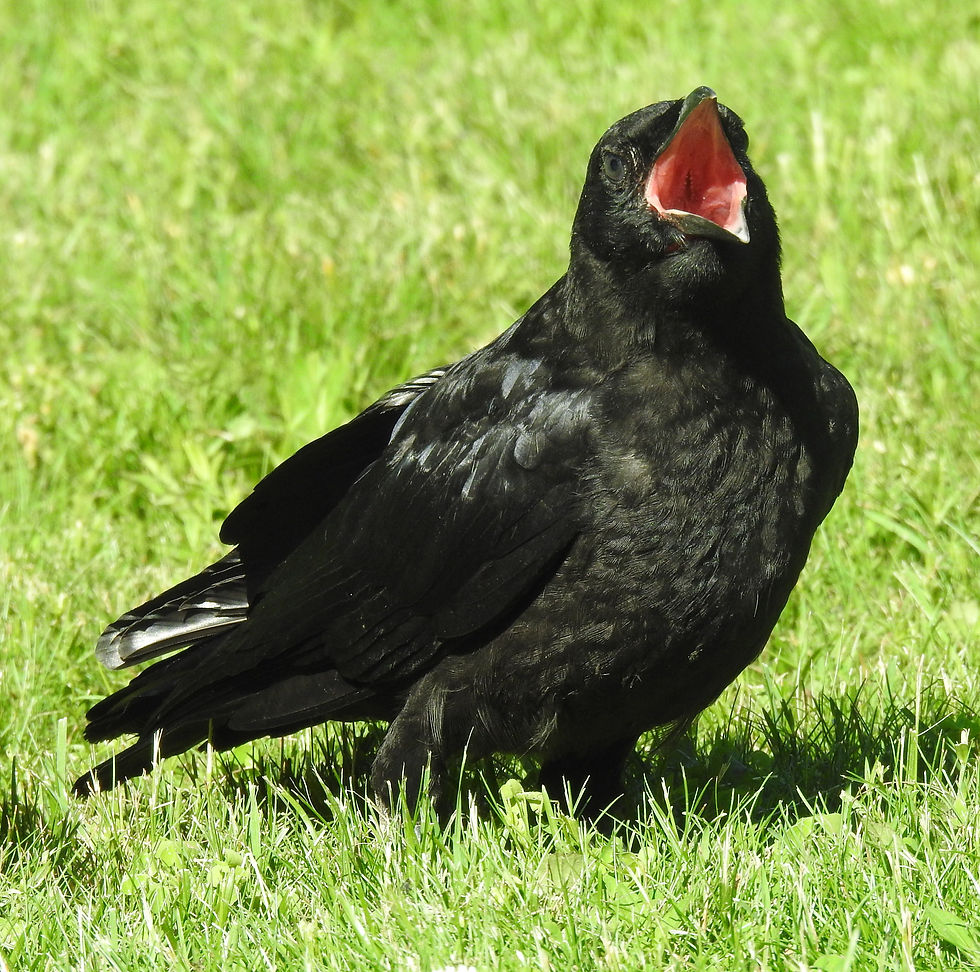Baby Crows, Baby! Caw!
- Sara Webley
- Jun 14, 2021
- 3 min read
I saw my first baby crow of the season today! Here in New England, we usually start seeing baby American Crows with their parents in June. My nature-fantasy middle grade novel Zo in the Roosting Tree takes place in July, and Zo is one of the year’s crow babies. Zo goes to crow-school, which is not so different from real crow life: babies stay with their parents for several years, learning from them, roosting together, and eating together.

Young crows depend on their parents for food. They’re fed in the nest for a few weeks before they’re ready to fly, and even after that. Crows usually hide their nests up high, near the trunk of a tree, often an evergreen. Some crow youngsters, or fledglings, may leave the nest before their flight feathers are fully developed. A predator like a red-tail hawk or an eagle might have scared them, and they leaped out of the nest. Then, these fledglings may hop around in the nesting tree or on the ground, or hide under low bushes for a couple of weeks before they can fly well enough.
But they’re still being watched and fed by their parents, even on the ground. Crow parents are very protective. When they have fledglings around, crows may dive-bomb humans. You’ve probably heard about this happening in cities like Portland and Seattle recently. But those crow parents are just protecting their babies!

A few weeks after hatching, when the crow fledglings have left the nest, they start following their parents and begging for food. That’s what I photographed a young crow doing today. It may be three or four months before the crows are able to get all their food by themselves. Young crows make noisy, persistent begging calls. Well, why not? They’re hungry! If you watch a crow family, you might see a very busy, tired-looking crow parent stuffing food into the baby’s wide-open mouth: seeds, worms, bits of roadkill, bread, garbage, and other yummy stuff. Older helpers—like last year’s brothers and sisters, or aunts and uncles—sometimes feed the babies too.
Baby crows may look like their parents, but they’re different in a couple of can’t-miss ways: First, baby crows have gray or blue eyes, not brown (they’ll slowly change to brown by the end of summer). Second, babies have very red mouths—on the inside, and at the corners—making it easier for the parents to see where to stuff in the food. Also, if you watch young crows moving around, you’ll see they’re kind of clumsy!

Crows may stay at home with their families for several years. American Crows don’t find a mate and breed until they’re at least two years old, and often not until they’re four or older. So adolescent crows help their parents raise the new babies. A crow family might have 15 members, including youngsters from five different years.
In Zo in the Roosting Tree, I gave Zo a smaller family, but she still depends on her parents, Corbin and Merla. They teach her crow-school lessons about watching out for danger, flying, and becoming an expert food-finder.
Caw!

** If you see a baby crow on the ground: Being on the ground can sometimes be dangerous because of predators like cats. If a baby crow is in clear danger—say, from a cat or a car—it can be moved up into the tree or a nearby bush. For advice, call a local licensed wildlife rehabber! They know what to do. The problem with “rescuing” young crows is that they’re usually doing fine and don’t need humans’ help. They’ll return to their family once they can fly well enough. When in doubt, leave the crow alone! **
For more info: Read John Marzluff’s books Gifts of the Crow and In the Company of Crows and Ravens — Visit Cornell Lab of Ornithology’s website: https://www.birds.cornell.edu/home — Follow Corvid Research Blog by Kaeli Swift: https://corvidresearch.blog







Comments